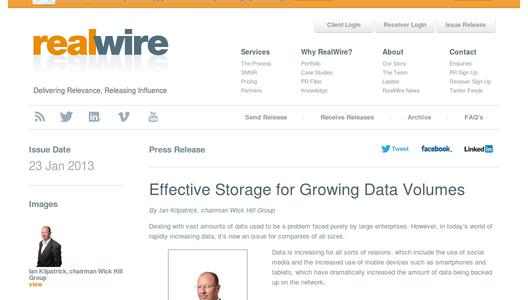Data is increasing for all sorts of reasons, which include the use of social media and the increased use of mobile devices such as smartphones and tablets, which have dramatically increased the amount of data being backed up on the network.
Symantec’s recent State of Information Survey conducted over 38 countries worldwide found that SMEs expected their storage to increase by 178% over the next year.
The large amount of data companies now produce, which can be in the terabytes and petabytes, needs to be backed up and stored so it can be accessed easily and quickly. It needs to be archived in case it is needed in the future and also for compliance reasons; and it needs to be replicated, so it’s available for use in the case of a disaster. All this needs to be done cost-effectively and securely.
Storage is a notoriously boring subject for many people, and it tends to get pushed down the list of priorities. While enterprises have the resources to manage their back-up and storage issues, many organisations consider it a necessary evil and don’t review its financial effectiveness or its fitness for future purpose.
This is a shame, as in all matters IT, times have moved on from things such as old-style tape systems. Modern solutions are bigger, better, easier and lower cost, often with features previously only available on enterprise systems.
Increases in data volume now make storage a key business issue for companies. Performance issues, which result from companies being overwhelmed by data or by backing up, could impact on profitability. The inability to access data quickly, in the event of a disaster, could put a company out of business.
Some recent statistics indicate that 43% of businesses that close after a natural disaster never re-open and a further 29% close within two years. One of the key reasons for this is the failure of their disaster-recovery planning. Back-ups and back-up plans need to be tested regularly to ensure that they are relevant or actually working. Finding that your back-ups are corrupted, when you absolutely need them, is too late.
Which route forward?
The question is how to choose a storage solution that will cope with current storage needs as well as taking you forward into a future of unpredictable, and mushrooming, data growth?
Storage solutions for companies outside the Top 500 range from traditional tape to the cloud, with other options and permutations in between. For some organisations, cloud may be the answer. For others, particularly if they have been using tape in the past, the leap to the cloud is just too great and they want something more tangible, such as disc-based storage.
For some, the solution may be a hybrid one which gives local back up with background cloud back-up. This option provides speed of access with the security of offsite cloud.
Companies still using traditional tape for back-up and archiving will be finding it increasingly inadequate for their needs, that is if they’ve checked recently. Tape also has inherent disadvantages.
It’s cumbersome, expensive, has a finite life and is easily damaged. It takes longer and longer, the more you are backing up. And it can be very difficult to find things quickly on tape when you need them.
The cloud, while it may seem like a great option to many, isn’t for everyone. One disadvantage of the cloud, which many aren’t aware of, is that the data is probably going to be stored on traditional tape.
Another issue to be aware of is how long it takes to seed and download data over limited capacity internet connections. Seeding a terabyte of data in the cloud on a 10mbps connection with nothing else going on will take 300 hours (12.5 days).
This means that accessing it and downloading it could take days. If you have a serious disaster recovery situation, this may possibly be acceptable, but it’s a serious hindrance if you need to access stored data quickly during the normal day-to-day running of a business.
Solutions
One solution for more conservative SMEs is to use RDX removable hard disc cartridges for storage. They combine the best of hard disc and tape storage. They scale with a business, but, unlike tape, are very rugged and reliable. It’s a step forward, for those who have been using tape, which isn’t too different from what went before.
RDX cartridges back-up and restore data very quickly (much quicker than tape) and are very secure. They are typically available in sizes from 160 gigabytes to 1.5 terabytes. You just add extra cartridges as your storage needs expand.
Imation, for example, which has a specialist division for SME storage, provides an RDX solution, the A8, which can accommodate up to 12 terabytes of data.
The A8 helps SMEs conduct high-performance back-up, data protection, archiving, restoration and cloud-enabling. It can mix RDX cartridges of different sizes, so users can start with lower capacity cartridges and add higher capacity ones as needs dictate.
A solution like this allows organisations to quickly back up and instantly access their crucial data. It gives them more operational flexibility and the ability to cost-effectively and quickly recover their data in the event of a disaster. Users get the benefits of RDX cartridge storage, but also keep cloud options open.
Imation also provides another product which gives companies a comprehensive set of storage and back-up options.
DataGuard is a network attached storage (NAS) backup appliance which uses hard disk drives, removable RDX® disk cartridges, replication, and cloud storage to provide up to four layers of data protection. It shortens back-up windows and allows for fast recovery.
DataGuard is capable of making multiple copies of content as local online copies, replicated copies, optional offline RDX copies and remote online (cloud) copies.
It means companies can have all bases covered. They don’t have to go with the cloud straight away, but the facility is there to do it when and if they are ready.
Another company which provides a solution which gives the best of both worlds, both local and cloud storage, is Barracuda with its Barracuda Backup Service.
This provides full local data back-up and is combined with a storage subscription, to replicate data to the cloud at two offsite locations. So organisations get onsite back-ups for fast restore times and secure, offsite storage for disaster recovery.
The Barracuda system uses a technology called deduplication, which reduces traditional back-up storage requirements by 20 to 50 times, while also reducing back-up windows and bandwidth requirements.
Deduplication works by eliminating redundant data. Only one unique instance of the data is actually retained. The redundant data is replaced with a pointer to the original copy.
Conclusion
One constant is guaranteed. Storage and data access requirements will (as they always have done) continue to grow, in fact the pace appears to be accelerating. Alongside the change in data volumes, new options have become available which provide enterprise-level solutions at affordable prices.
A range of such options is available from RDX cartridges to cloud services, plus a variety of combinations in between. Such solutions allow organisations to effectively back-up and store data, so it doesn’t cause serious performance problems on the network; they allow the data to be quickly available for both the running of the business and for compliance purposes; and they offer a disaster recovery option.
Bio of author
Ian Kilpatrick is chairman of international value added distributor Wick Hill Group plc, specialists in market development for secure IP infrastructure solutions and convergence. Kilpatrick has been involved with the Group for more than 35 years. Wick Hill supplies organisations from enterprises to SMEs, through an extensive value-added network of accredited VARs.
Kilpatrick has an in-depth experience of IT and unified communications (UC) with a strong vision of the future. He looks at these areas from a business point-of-view and his approach reflects his philosophy that business benefits, ease-of-use and cost of ownership are key factors, rather than just technology. He has authored numerous articles and publications, as well as being a regular speaker at conferences, exhibitions and seminars. For more information about Wick Hill, please visit http://www.wickhill.com or www.twitter.com/wickhill.


